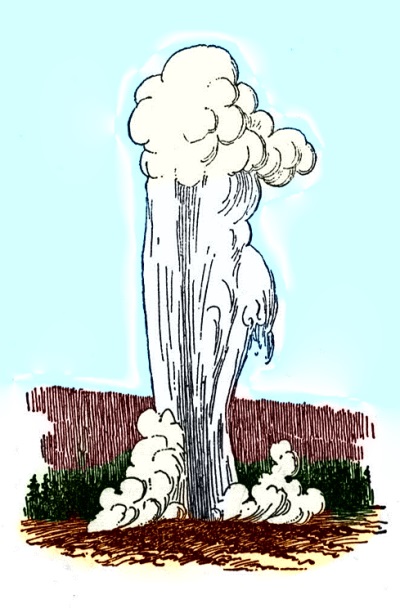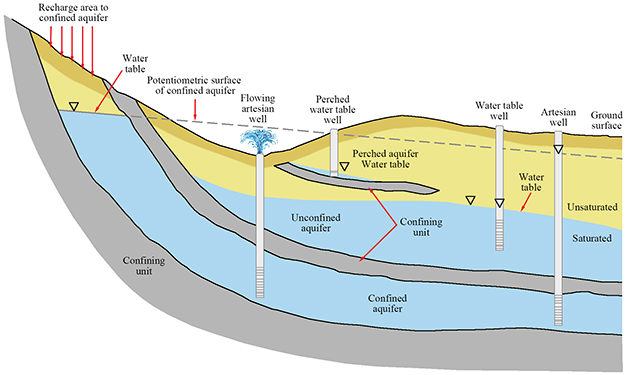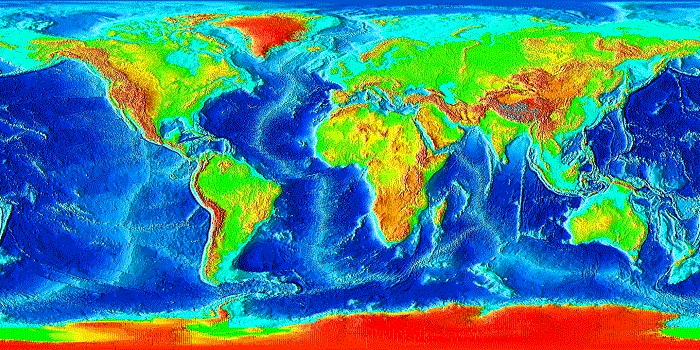The Fountains of Noah's Flood and the Windows of Heaven

The Bible says that the waters of Noah's flood covered all of the Earth to above the peaks of the tallest mountains:
"And the waters prevailed exceedingly upon the earth; and all the high hills, that were under the whole heaven, were covered. Fifteen cubits upward did the waters prevail; and the mountains were covered."
(Genesis 7:19-20 KJV)
If this flood was literal and global, then we are confronted with the "Mount Everest" problem. Located in Nepal, Mount Everest is the Earth's highest peak. It is also the highest peak in a range of mountains stretching across 1,500 miles and containing more than 1000 peaks higher than 20,000 feet.
Mount Everest is presently at a height of 29,028 feet above sea level and getting taller at the rate of about 3-5 millimeters per year. Assuming the tectonic uplift rate of the Himalayan range has been uniform since the days of Noah's flood, Mount Everest would have been only about forty-three (43) feet shorter (28,985 ft.) back in Noah's day. That is still a considerable height, equal to about 5.5 miles above present sea level. It would take a lot of water for the flood to reach that depth - more water than is presently above the crust of the earth. Where did so much water come from and where did it go after the flood?
Before answering that question, let's put this puzzle into perspective. Our Earth is about 25,000 miles in circumference. If it was compared to the size of a basketball, the Earth's crust would be about as thick as a sheet of tissue paper wrapped around it. In a global perspective, 5.5 miles of water above today's sea level is a relatively minute quantity, increasing overall circumference by only 0.044%. Of course, to people on the order of five to six feet in stature, 5.5 miles is a lot. The thing to keep in mind is perspective.
Many Young Earth Creationists (Creation Scientists) espouse the theory that most of the Earth's mountains and sedimentary rock strata were formed underwater during Noah's flood by massive global volcanic and tectonic activity. They then conclude that because the mountains formed during the flood, not as much water was needed to cover the Earth to "fifteen cubits" above the highest mountain as Genesis 7:20 requires. Nice try, but no prize.
That answer does not meet the Scriptural or geophysical requirements, as the Bible clearly says that the mountains were already there, and by implication, the continents and tectonic plates were in their present-day locations, give or take a hundred yards to account for 4,000+ years of continental drift. Additionally, the alleged underwater volcanic and tectonic activity, on such a massive scale as proposed by Creation Science models, would have produced a great deal of acid which would be detectable as SO4 ions in the Greenland Ice Sheet core record. That evidence is simply not there. This is covered in more detail in another chapter. (See, Global Dust Spikes, Greenland Ice Sheet, Paleoclimate Indicators and Collapse of Civilizations All Correlate to Date of Noah's Flood)
Instead of taking the usual approach - that Noah's Flood could not have happened because of this fact or that fact - let's approach the problem from this angle: Noah's Flood did happen because the Bible is true, so let's try and find answers that can fit the facts, both scientific and Biblical. After all, Jesus Himself confirmed that the flood was a real event (see: Mt 24:37-38; Lu 3:36; Lu 17:26-27), so there must be an explanation. First, let us closely examine the exact wording of the Bible to begin determining the correct answers to this mystery.
"And God said unto Noah, The end of all flesh is come before me; for the earth is filled with violence through them; and, behold, I will destroy them with the earth."
(Genesis 6:13 KJV)
Notice that the Lord says the agency of destruction would be the Earth itself. The planet Earth has three spheres: the core, mantle, crust (lithosphere), the seas (hydrosphere), and the air in the heaven above (atmosphere). All three of these played a part in the destruction of the antediluvian world, so the complete answer is not necessarily confined to just geology but it is confined to the Earth.
"In the six hundredth year of Noah's life, in the second month, the seventeenth day of the month, the same day were all the fountains of the great deep broken up, and the windows of heaven were opened. And the rain was upon the earth forty days and forty nights."
(Gen 7:11-12 KJV)"The fountains also of the deep and the windows of heaven were stopped, and the rain from heaven was restrained;"
(Gen 8:2 KJV)
According to the above Scriptures, there were two related sources for the waters of Noah's flood. There were "fountains" of water coming up out of the Earth and there was water coming down from the "windows" of heaven. The fountains began first and triggered a complex chain reaction that brought the rain. These fountains came from below the Earth's crust then affected things far into the upper atmosphere.
There are two types of water fountains that occur in nature. One is called an Artesian well/spring. Artesian wells occur when a hole penetrates into the earth to a region where internal pressure causes the water to flow upward like a fountain.

The internal pressure that drives such fountains is produced when the head of the particular water table penetrated is at a higher elevation than the spring opening. The principle is similar to the gravity pressure that drives water out of your sink tap because the city water supply is stored in an elevated tower above the town.
The second type of fountain is called a geyser. Geysers occur when waters in underground chambers are heated by the surrounding host rock until the pressure and temperature cause them to flash to steam and erupt upwards. When the chamber is emptied, replacement water flows back into the chamber, the replacement water is heated, and the cycle repeats. An excellent example of this is seen in Yellowstone National Park's "Old Faithful" geyser.
According to what is written in the Scriptures, the fountains of Noah's flood may have been a similar form of geyser activity on a massive, world-wide scale, concentrated along the mid-oceanic ridge system and driven by water-saturated magma accumulated below the oceanic crust. A careful reading of Genesis 7:6-10 indicates that the flood waters were already rising for about seven days before the fountains "were broken up" and broke forth in full output.
"And Noah was six hundred years old when the flood of waters was upon the earth. And Noah went in, and his sons, and his wife, and his sons' wives with him, into the ark, because of the waters of the flood. Of clean beasts, and of beasts that are not clean, and of fowls, and of every thing that creepeth upon the earth, There went in two and two unto Noah into the ark, the male and the female, as God had commanded Noah. And it came to pass after seven days, that the waters of the flood were upon the earth. In the six hundredth year of Noah's life, in the second month, the seventeenth day of the month, the same day were all the fountains of the great deep broken up, and the windows of heaven were opened. And the rain was upon the earth forty days and forty nights."
(Genesis 7:6-12 KJV)
Careful parsing of the above passage indicates that great amounts of water were already being added to the Earth's seas at least seven days before the rains even began. This means that sea level was already rapidly rising, flooding low lying coastal areas and sending panicked low-land inhabitants inland from the rising seas. Meanwhile, presumably up on much higher ground, Noah and his family took shelter in the massive gopher wood vessel which remained firmly nested in its construction frame, unmovable and secure until the rising waters lifted it from its resting place.
The great volume of water this early in the flood event could only come from massive undersea "fountains" beginning to breech the crust all along the mid-oceanic ridge system. But this preliminary out-flow was still insufficient to breech the ocean's surface. The volume of underwater displacement would, however, be sufficient enough to generate global tsunami (tidal waves) activity, quickly drowning inhabitants who lived near the seas.
Seven days into the flood the undersea fountains broke through the crust in full fury, and the pressure of the flow sent scalding columns of superheated water upwards, breeching the ocean's surface and erupting skyward as a globe-encircling curtain of steam rocketing into the upper atmosphere. As the steam came into contact with the colder air it would condense and produce cloud cover and relentless rainfall on a planetary scale. This is precisely the sequence of events described in this part of the passage:
"In the six hundredth year of Noah's life, in the second month, the seventeenth day of the month, the same day were all the fountains of the great deep broken up, and the windows of heaven were opened. And the rain was upon the earth forty days and forty nights."
(Gen 7:11-12 KJV)
NOTE: Hydrothermal fluid temperatures coming out of present-day vents on the ocean floor can reach 400°C (750°F) or more, but they do not boil under the extreme pressure of the deep ocean. See: Hydrothermal Vents
This first passage, at the beginning of the flood, says that the rains did not begin until AFTER the fountains of the great deep are broken up.
"The fountains also of the deep and the windows of heaven were stopped, and the rain from heaven was restrained;"
(Gen 8:2 KJV)
The second passage says the rains ceased only AFTER the fountains stopped. This is fully consistent with a geyser-type model.
As briefly mentioned earlier, the most likely geological location for the "fountains" (geysers) was along a narrow, globe encircling series of underwater Tectonic Plate boundaries called the mid-oceanic ridge, where the Earth's oceanic crust is currently spreading apart at the rate of a few centimeters per year. This continuous system of faults is seen on a map of the Earth's sea floors as running south down the middle of the Greenland Sea and the North and South Atlantic Oceans. It then extends eastward into the Indian Ocean basin, onward between Australia and Antarctica and into the great Pacific Ocean basin. It then continues northward along the eastern side of the Pacific basin.

Scientists are studying what they term as a large "open wound" where the Earth's oceanic crust is missing deep under the Atlantic Ocean near that ridge system. What scientists are keen to know is whether the crust was ripped away by huge geological faults, or whether it never even developed in the first place. Could this be an actual location where the fountains of the great deep were "broken up" as the Bible indicates? Read the story: Serpentinite not crust, scientists to find out how part of Earth's crust went missing.
The geysers' source would have been extensive underground reservoirs of magma supersaturated with water that had collected in the regions below the boundary of the oceanic crust and above the underlying mantle region. The next graphic is a simplified schematic cross-section of the Atlantic Ocean basin, with the mid-oceanic ridge at the center.

Here is an important question to note: Why would magma, supersaturated with water, only accumulate under the crust of the oceans and not under the continents? There are two reasons. First, water, being much lighter than rock, would have gravitated upwards until it was blocked by the crust. It would then tend to pool between the Crust-Mantle boundaries. Secondly, because the Earth's crust is much thinner under the ocean floors (5 - 12 km) than under the continents (35 km average), it would naturally pool where the Earth's crust was thinnest - under the basaltic oceanic basins which ride higher on the mantle.
The underground region where this water-saturated magma would have collected is above a zone called the Asthenosphere, commonly known as the Mohorovic discontinuity. The behavior of seismic waves passing through that region appears to show relative liquidity as compared to the rock in the regions above and below it. See also: "Keeping Earth's Plates Oiled" and "Lab study suggests small layer of water, CO2 and silicate lies beneath tectonic plates."

Graphic from
https://www.geog.ouc.bc.ca/physgeog/contents/images/lithosphere.jpg
Scientists have found evidence to confirm the presence of large volumes of water deep inside the Earth, enough to fill Earth's ocean basins 10 times over (see also Earth Mantle 'Ocean': 3-D Seismic Model Of Vast Water Reservoir Revealed). Only a fraction of such an amount would be required to raise sea levels to meet the requirements of Noah's flood. By the way, long before scientists learned there were vast amounts of water under the Earth, the Bible already hinted at this fact (see Exodus 20:4).
If a large volume of water-saturated magma had pooled under the Earth's ocean basins, it is probable that the oceans were much shallower back then as compared to the Post-Flood times of today. Earth's sedimentary geology is replete with evidence of shallow-water sea depositions. And that same geology reveals fluctuations in global sea levels across geologic time that greatly exceed what could possibly be caused by accumulations and melting at the polar caps. One of the possible explanations put forth to explain this mystery is "sea floor warping" and periodic accumulations and releases of waters from supersaturated magma, as proposed in this model, and that could account for this observation. In addition, it would be more likely that a rupture in the crust would occur, and these waters released, if the accumulation of magma below the oceanic crust was placing great upward pressure against the crust.
Therefore, we will assume that at the time just before Noah's flood the seas were more shallow than today. If this was indeed the case, then explaining how much of the flood waters rapidly receded becomes simple to explain. Basic law of Physics: For every action there is an equal and opposite reaction. After the great volume of waters which were formerly trapped below the Earth's oceanic crust jetted upwards, condensed, and fell into the regions above the oceanic crust, they quickly began to produce an accumulative great reverse-pressure on the thin crust of the ocean floor.

In the meantime, because of the sudden release of the great pressure in the supersaturated magma below the crust, there would have been a relative cooling effect on the remaining magma body. This cooling, along with the loss of the volatiles (the waters), would reduce the volume of the underlying magma chamber, causing it to shrink. This would facilitate the crust being pushed downward by the weight of the surface waters above and thus forming the vast Abyssal plains we see today on both sides of the mid-ocean spreading ridge.

This downward warping of the ocean floors and the mid-oceanic ridge system can be clearly seen in the Global Relief Map below:

Based on sea mount and Continental Shelf evidence (discussed in detail in the chapter concerning the Days of Peleg), sea level after Noah's flood abated to a level about 1,000 meters higher today than it was before the flood.
And that is the basic proposed geologic component of the Flood Model. Below is a short video that may help you better visualize the "Fountains" model of the great flood.
In the next chapter you will learn about the complex chain reaction this triggered in the Earth's atmosphere and the resultant changes that sharply decreased the life-span of man on this side of the flood.
Before proceeding to other aspects of the flood event, we need to address an objection to this geologic model posed by accepted plate tectonic theory: If sea floor spreading and volcanic activity along the mid-oceanic ridge has been ongoing for millions of years, what explains this anomalous eruption of waters at this particular point in the Earth's history? This is a fair question, for which I only have a Biblical answer.
The reader will note that in the days of Adam the vegetation of the Earth was watered by a mist that came up out of the ground:
"And every plant of the field before it was in the earth, and every herb of the field before it grew: for the LORD God had not caused it to rain upon the earth, and there was not a man to till the ground. But there went up a mist from the earth, and watered the whole face of the ground."
(Genesis 2:5-6 KJV)
This "mist" seems to indicate that there was a great deal of heated water present under the Earth and relatively close to the surface, or at least making its way to the surface at various places in order to produce this mist. A Divine reconfiguration of the Earth's geology, during the process of the seven days of Genesis when God made the "foundation of the world" (See the chapter entitled "Creation or Catabolism?"), is the only possible explanation. Surely the Lord knew that He had created an unstable situation that would eventually cause the flood centuries later in the days of Noah. Granted, this is not a scientific answer, but one that is theologically sound given our understanding of God's omnipotence and foreknowledge.
The bottom line is that the geologic conditions that produced the massive geysers of Noah's days, however they came about, no longer exist. Therefore, there can be no repeat of this activity on such a great scale (See Genesis 9:15 for confirmation). In other words, the very mechanics and conditions that produced the great flood event self-destructed upon completion of the flood event cycle, thus the geologic changes became permanent. So, unlike the "Old Faithful" geyser, this was a one-time event.
In the next chapter we will discuss why the age-span of mankind greatly decreased after the flood. We will also explain how Noah and his family, to say nothing of all sea creatures, survived being par-boiled by the heat released when the massive geysers erupted in the middle of the Earth's great oceans.
Disclaimer: External Links
from this website are for instructional or promotional purposes and do not
constitute an endorsement
by the The Bible, Genesis & Geology Ministry.
All original text © 1997 -
2021
Gaines R.
Johnson, D.D., D.Th.
The Bible, Genesis & Geology Ministry
Materials from this site may
be freely copied to paper for personal use or church Bible studies.
They may not be reproduced
elsewhere on the Internet, for either personal or commercial use, without
the express written permission of this Ministry.
Are you saved? Are you Sure? Click the image below for the Gospel Truth about the Lord Jesus Christ in your native language!


